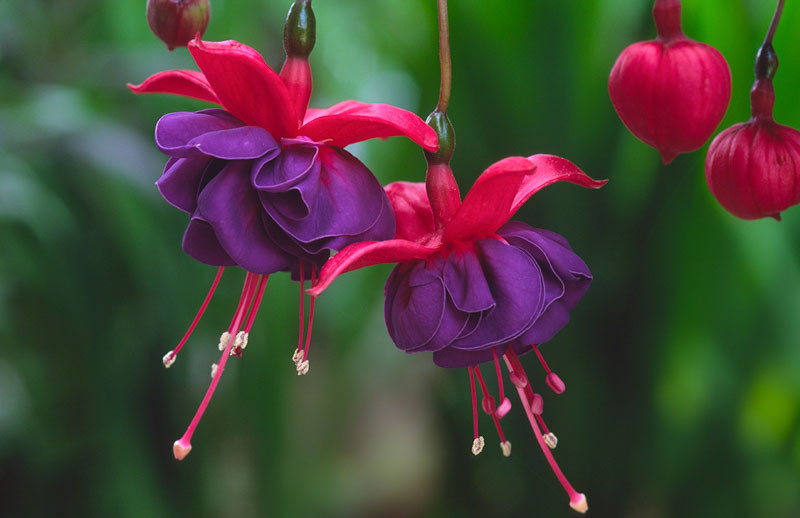Dark Eyes fuchsia is an exotic looking tender perennial prized for its elegant two-tone blooms. This versatile plant adds vibrant color and graceful charm when used in borders, beds, containers or hanging baskets. With its prolific flowering and easy care requirements, Dark Eyes fuchsia is sure to be a showstopper in any garden. Here is a complete guide to successfully growing these stunning plants.
Overview of Dark Eyes Fuchsia
Dark Eyes is a free-flowering trailing fuchsia cultivar that blooms abundantly without deadheading It features deep blue petals contrasted by bright red sepals for a vivid bicolor effect This variety reaches 4-8 inches tall and spreads 18-24 inches wide. Dark Eyes thrives in partly shaded spots and produces flowers continuously from spring through fall frost. Its medium texture blends well with other plants and works beautifully spilling from containers.
Growing Conditions for Dark Eyes Fuchsia
- Location: Partial shade or filtered sun is ideal. Avoid hot afternoon sun.
- Soil: Rich, well-draining soil amended with compost.
- Water: Consistently moist but not saturated. Allow soil to slightly dry between waterings.
- Temperature: Above 60°F/15°C. Bring indoors or protect from frost.
- Humidity: Average humidity levels.
- Fertilizer: Liquid fertilizer every 2-3 weeks at half strength during growth.
Dark Eyes fuchsia flourishes in partly shaded areas protected from intense sun which can scorch leaves. These tropical plants require warm temperatures and should be grown as annuals in all but the warmest climates where they may overwinter. Well-draining fertile soil kept evenly moist encourages the best growth and flowering. Regular feeding is beneficial for vigorous plants.
How to Plant Dark Eyes Fuchsia
Dark Eyes fuchsia is easy to grow from nursery starts. Follow these planting tips:
-
Select a part sun site with rich, compost-amended soil.
-
Dig a hole the same depth as the root ball and place the plant inside.
-
Backfill the hole with soil, firming gently.
-
Water thoroughly after planting.
-
Space plants 18-24 inches apart. Allow 1 plant per 10-12 inch container.
-
Pinch off flowers in the first 2-3 weeks to promote bushy growth.
-
Add mulch around plants to conserve moisture.
Caring for Dark Eyes Fuchsia Plants
-
Water regularly to keep soil consistently moist, allowing it to slightly dry between waterings.
-
Fertilize every 2-3 weeks during growth with diluted liquid fertilizer.
-
Prune out any dead, damaged or overlong stems as needed.
-
Bring potted plants indoors before frost and overwinter in a sunny window.
-
Watch for pests like aphids, whiteflies and spider mites. Use organic controls if found.
-
Propagate by taking 4-6 inch summer tip cuttings. Root in moist potting mix.
Pay close attention to watering, fertilizing, pruning and pest monitoring to keep Dark Eyes fuchsia plants looking their best. Proper care results in vigorous growth and abundant trailing blossoms.
Overwintering Dark Eyes Fuchsia
-
Gradually reduce watering frequency as plants enter dormancy. Do not fertilize in winter.
-
Provide as much natural light as possible by a sunny window. Supplement with grow lights.
-
Maintain indoor temperatures above 60°F/15°C. Protect from cold drafts.
-
Remove dead foliage over winter. Resume light watering in early spring.
-
Prune stems back by 1/3 to 1/2 before moving plants outside in spring.
-
Acclimate plants slowly over 7-10 days before permanently placing outdoors.
With careful treatment, potted Dark Eyes fuchsia can be overwintered as a houseplant and returned to the garden annually. Monitor light, humidity, temperatures and watering for success.
Troubleshooting Common Fuchsia Problems
-
Wilting – Caused by too little water. Water thoroughly until it drains from the container bottom.
-
Leaf drop – Indicates overwatering or cold drafts. Improve watering and temperatures.
-
Leggy growth – Not enough light. Move to a brighter location or prune back stems.
-
Lack of flowers – Too much shade, overpruning or overfeeding. Ensure optimal conditions.
-
Pest damage – Inspect regularly and treat with organic controls. Remove damaged parts promptly.
Tips for Growing Dark Eyes Fuchsia
-
Place in partial sun or bright shade protected from hot afternoon sun.
-
Plant in fertile, well-draining soil amended with compost or organic matter.
-
Water regularly to maintain evenly moist soil, allowing it to slightly dry between waterings.
-
Feed every 2-3 weeks during growth with a balanced liquid fertilizer.
-
Prune back overlong, dead or damaged stems as needed to shape plant.
-
Bring container plants indoors before frost or overwinter hardy types with mulch protection.
-
Watch for common fuchsia pests and treat promptly with organic controls.
With its elegant two-tone blooms and easy care nature, Dark Eyes fuchsia is sure to be a star in any garden. Follow this complete guide for successfully growing these exotic looking plants and enjoying their beauty from spring through fall!

Fuchsia hybrid ‘Dark Eyes’
Photo courtesy of D.S. Cole
- Deep blue corollas with red sepals spring to fall
Fred Meyer Fuchsia Basket Planting & Care
0
